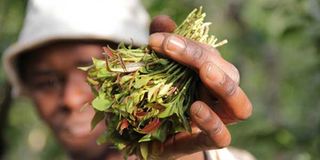Miraa's effect on mental health divides opinion

Miraa also known as khat is a stimulant, which is said to cause excitement and euphoria; also brings loss of sleep and appetite. WHO classified it as a drug that can produce psychological dependence but did not consider its addiction to be seriously problematic. PHOTO | FILE
What you need to know:
- Researchers have disqualified perceptions that people who chew miraa are prone to mental disorders.
- A study that was released by the University of Nairobi (UoN) and University of Konstanz, Germany which reported high rates of mental illnesses among heavy miraa users in Nairobi was deemed to lack merit.
- Although the prevalence of mental disorders among those who chew miraa stood at 12.4 per cent compared to 7.8 per cent among those who do not use the stimulant, the lead researcher of the study, Prof Charles Mbakaya, said the increased instances of mental disorder among those who use the stimulant cannot be attributed exclusively to it.
If you thought miraa makes its users go mental, think again.
Opinion appears divided over the long-term effects of a herb that has been chewed over the years as a social custom and as a recreation activity. European countries too have banned the herb for various reasons but usually terming the herb a health risk. A new report however, absolves the herb from the indictment that it makes its users go crazy.
Researchers have disqualified perceptions that people who chew miraa are prone to mental disorders. They said that the study that was released by the University of Nairobi (UoN) and University of Konstanz, Germany which reported high rates of mental illnesses among heavy miraa users in Nairobi did not have merit.
The Nairobi University study released late last month received backlash with its conclusion that heavy miraa users are depressed, suffer from post-traumatic disorder (PTSD) considered a mental problem which is caused by stressful events. The study contradicts one that was conducted by Kenya Medical Research Institute which gave the herb a clean bill of health.
Miraa also known as khat is a stimulant, which is said to cause excitement, loss of sleep and appetite and causes euphoria. The World Health Organization (WHO) classified it as a drug that can produce psychological dependence but did not consider its addiction to be seriously problematic.
Miraa farmers in Meru disputed the findings of the study arguing that they and their ancestors have always chewed miraa and they have never had mental issues.
BIASED RESEARCHERS
Speaking during the sixth East African health and science conference, in Bujumbura, Burundi, Dr Evans Amukoye, faulted the study saying that any research needed to sample the right population before generalizing the findings.
“Sometimes scientists control for factors that can cause bias either during recruitment (exclusion criteria) or during analysis?”
Dr Amukoye however, said that heavy use of miraa and other mind-altering substances may suffer severe side effects of the same.
“Even 'paracetmol’ is the commonest cause of liver failure but not if taken at recommended dose,” he added.
Another report released last month by the government scientists, Miraa has no negative health impact.
However, the report by the Kemri discredit the grounds in which Britain, the US, France, Switzerland, and Sweden banned use of the stimulant in their territories on grounds that it has adverse health effects.
“People who chew herb, also known as khat, are less likely to be obese because their appetite is suppressed, or develop heart complications in the future. And, better yet, their reproductive health is in tip-top shape,” says the study.
Although the prevalence of mental disorders among those who chew miraa stood at 12.4 per cent compared to 7.8 per cent among those who do not use the stimulant, the lead researcher of the study, Prof Charles Mbakaya, said the increased instances of mental disorder among those who use the stimulant cannot be attributed exclusively to it.
“We observed that there was significant use of other things like tobacco, alcohol, cocaine, and bhang that predisposed the chewers to mental disorders,” explained Prof Mbakaya.
“In fact, we subjected the data through finer levels of analysis which showed that miraa did not cause these psychotic disorders.”
Dr Amukoye said the study from KEMRI also found more mental illness in users of Khat but when they controlled for alcohol and other drug use (which were common among Khat users) the association was not there.
“Please note the analysis stratified by how heavy a user they were was not done. We can still check our raw data and see if we can analyse this,” he said.
Researcher Joyce Ondicho who also did a research to investigate microbial effects of the herb in Meru and Embu counties said that several factors were not considered in the Nairobi study.
“We need to have sub-analysis of the study. Regardless of the amount of Miraa chewed, the mental bit has to be investigated further,” she said.
Dr Amukoye said another factor that the author did not interrogate is the causal relationship.
PLACATING DONORS
“The best design for this would be a cohort study in which you pick early starters of the use of Khat and follow them over years and see if all other things are constant, takers of miraa develop mental illness or is it those with mental illness who are heavy miraa takers,” he said.
He said the preliminary results that were released by the Nairobi study were to the funders to show them where their money had gone and unfortunately it is public knowledge.
The four day event brought together more than 800 experts and stakeholders within and outside East African Commission.
These includes EAC ministers, responsible for EAC affairs, EAC ministers of health, members of parliament, development partners, private sector, researchers, health professionals, policy makers and practitioners.
He said it was not common knowledge but the preliminary results that were released by the Nairobi University study served to placate donors who had funded the study by producing an outcome they knew to be favourable with them showing where their money had gone.
The four day event brought together more than 800 experts and stakeholders within and outside East African Commission.
These includes EAC ministers, responsible for EAC affairs, EAC ministers of health, members of parliament, development partners, private sector, researchers, health professionals, policy makers and practitioners.





